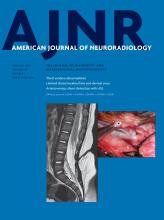Index by author
Einspieler, C.
- FELLOWS' JOURNAL CLUBPediatric NeuroimagingOpen AccessWhite Matter Injury and General Movements in High-Risk Preterm InfantsC. Peyton, E. Yang, M.E. Msall, L. Adde, R. Støen, T. Fjørtoft, A.F. Bos, C. Einspieler, Y. Zhou, M.D. Schreiber, J.D. Marks and A. DrobyshevskyAmerican Journal of Neuroradiology January 2017, 38 (1) 162-169; DOI: https://doi.org/10.3174/ajnr.A4955
Cerebral palsy has been predicted by analysis of spontaneous movements in the infant termed “General Movement Assessment.” The authors evaluated the utility of General Movement Assessment in predicting adverse cognitive, language, and motor outcomes in very preterm infants and attempted to identify brain imaging markers associated with both adverse outcomes and aberrant general movements in 47 preterm infants using MRI volumetric analysis and DTI. Nine infants had aberrant general movements and were more likely to have adverse neurodevelopmental outcomes, compared with infants with normal movements. In infants with aberrant movements, Tract-Based Spatial Statistics analysis identified significantly lower fractional anisotropy in widespread WM tracts. They conclude that aberrant general movements at 10–15 weeks' postterm are associated with adverse neurodevelopmental outcomes and specific white matter microstructure abnormalities for cognitive, language, and motor delays.
Enzinger, C.
- EDITOR'S CHOICEAdult BrainOpen AccessHippocampal and Deep Gray Matter Nuclei Atrophy Is Relevant for Explaining Cognitive Impairment in MS: A Multicenter StudyD. Damjanovic, P. Valsasina, M.A. Rocca, M.L. Stromillo, A. Gallo, C. Enzinger, H.E. Hulst, A. Rovira, N. Muhlert, N. De Stefano, A. Bisecco, F. Fazekas, M.J. Arévalo, T.A. Yousry and M. FilippiAmerican Journal of Neuroradiology January 2017, 38 (1) 18-24; DOI: https://doi.org/10.3174/ajnr.A4952
Brain dual-echo, 3D T1-weighted, and double inversion recovery scans were acquired at 3T from 62 patients with relapsing-remitting MS and 65 controls. Focal WM and cortical lesions were identified, and volumetric measures from WM, cortical GM, the hippocampus, and deep GM nuclei were obtained. Compared with those with who were cognitively preserved, patients with MS with cognitive impairment had higher T2 and T1 lesion volumes and a trend toward a higher number of cortical lesions. Significant brain, cortical GM, hippocampal, deep GM nuclei, and WM atrophy was found in patients with MS with cognitive impairment versus those who were cognitively preserved. The authors conclude that hippocampal and deep GM nuclei atrophy are key factors associated with cognitive impairment in MS.








